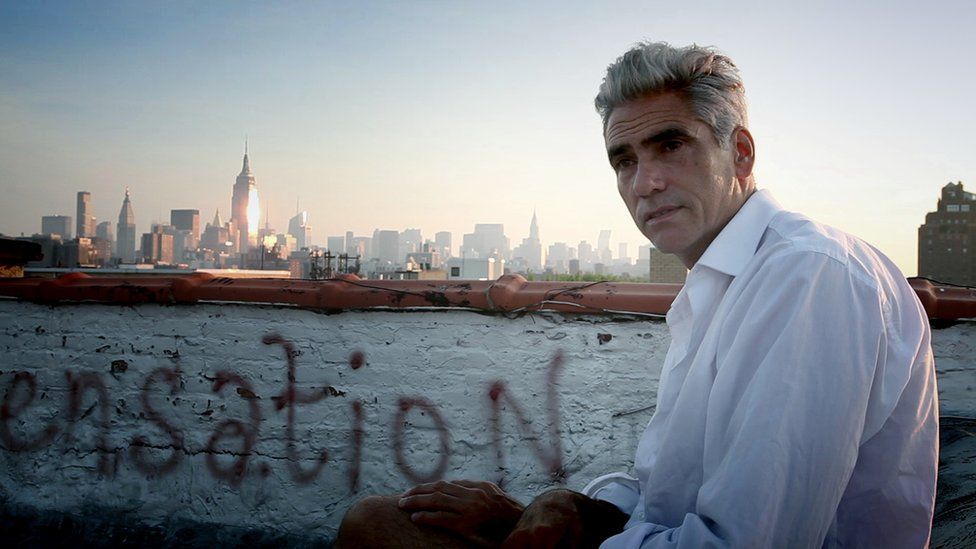Homeless model: New York's hidden homeless
- Published

Amid a documented rise in the number of homeless in New York City, many of those without homes may be effectively invisible - going about seemingly normal routines and even work without a place to live.
Walking through Tompkins Square Park in Manhattan's trendy East Village, Mark Reay recalls a corner of the park that was once a big part of his daily routine.
"There's a water fountain here where I could rinse my mouth out and brush my teeth and there's a bathroom over here," he says.
Reay, a former model, is tall and silver-haired. Sharply dressed, he walks with long strides.
Behind him, near the park's public bathroom, a collection of the neighbourhood's homeless have gathered on the benches.
"It's a little harrowing because it's a very seedy bathroom. There are all kinds of characters here," he says. "But I would shave in the sink, change into a suit. Very often I would need to get a quick start to the day and this is where I would come."
"It's what I call my well-dressed man disguise, so I generally didn't raise too many eyebrows."
Reay was disguising his homelessness. He was sleeping on the rooftop of a nearby building at the time.
But he was also working a number of jobs - as a photographer who worked for glamour magazines, a part-time model and an extra on film sets.
This work was, as Reay puts it, "high-profile but low-profit". He couldn't afford the rent for an apartment in New York.
For six years, Reay lived this unusual life - sleeping on a rooftop at night, and changing into a sharp outfit during the day.
It started when he was between paycheques and without a home, but didn't want to outstay his welcome sleeping on a friend's couch.
He would occasionally help a friend who took care of a building in the East Village, and who lent him the keys to the six-storey building.
One night, Reay walked up to the rooftop and decided he would sleep there for a few nights until he got paid.
The temporary solution became a way of life. "It's difficult to move into an apartment, you need the first and last month's rent plus security," says Reay.
But Reay is also an adventurer of sorts, and says he enjoyed his time living "off the grid".
What he could afford was a gym membership, which he relied on when he couldn't use the park to preserve that "disguise" of the sharply dressed, affluent man.
"I never wanted my problem to be someone else's by asking for charity or living on someone's couch for free," he said.
Three years ago, he met up with an old friend, Thomas Wirthensohn, an Austrian filmmaker.
"Over a drink Mark told me his crazy story," Wirthensohn says.
"I was looking for a story that I wanted to do, and I knew right away that this is it."
When Wirthensohn first saw the rooftop, he remembers being shocked by Reay's bed - a "nest" made with a few sheets of tarpaulin in a seven-foot triangular space, which was wedged between two adjoining buildings. Getting to this spot required some effort.
"I had to crawl out onto a ledge," says Reay, "then scamper around to the other side by holding on to the fence that separated the two buildings."
The spot was well-hidden from view and offered some protection from the weather.
The documentary, Homme:less, was recently released in US theatres, and is expected to come to iTunes next month.
Mark Reay's story is unusual, in many ways reflecting his own eccentricities.
But it's not uncommon, says Jeff Foreman, policy director of Care for the Homeless, an advocacy group in New York City.
"People work next to or know someone who would never appear to be homeless but who really is."
Housing units are in short supply here and rents are rising faster than wages, which has led to a well-documented increase in the number of homeless.
But Foreman says the "hidden homeless" - people like Mark Reay who sleep in unusual places or more commonly, their cars - are harder to identify.
"The people who are in that category don't want to be found and they're usually pretty good at it," says Foreman.
Officially, 57,000 people sleep in homeless shelters. But that doesn't count those living on the street, and it wouldn't count the "hidden" either. So a true picture of homelessness in New York is difficult to come by, Foreman says.
A recent report found about 300 full-time municipal workers in New York were actually homeless.
"We live in a city with 1.5m people living below the poverty line - that means we have 1.5m people at risk of being homeless," says Foreman.
Tom Brook reviews the film Homme Less in New York
Mayor Bill de Blasio has vowed to create more affordable housing to fix these problems. Until then, people like Mark Reay are left to their own devices to find a place to sleep.